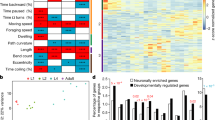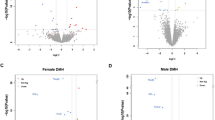Abstract
There are fundamental similarities between sleep in mammals and quiescence in the arthropod Drosophila melanogaster, suggesting that sleep-like states are evolutionarily ancient1,2,3. The nematode Caenorhabditis elegans also has a quiescent behavioural state during a period called lethargus, which occurs before each of the four moults4. Like sleep, lethargus maintains a constant temporal relationship with the expression of the C. elegans Period homologue LIN-42 (ref. 5). Here we show that quiescence associated with lethargus has the additional sleep-like properties of reversibility, reduced responsiveness and homeostasis. We identify the cGMP-dependent protein kinase (PKG) gene egl-4 as a regulator of sleep-like behaviour, and show that egl-4 functions in sensory neurons to promote the C. elegans sleep-like state. Conserved effects on sleep-like behaviour of homologous genes in C. elegans and Drosophila suggest a common genetic regulation of sleep-like states in arthropods and nematodes. Our results indicate that C. elegans is a suitable model system for the study of sleep regulation. The association of this C. elegans sleep-like state with developmental changes that occur with larval moults suggests that sleep may have evolved to allow for developmental changes.
This is a preview of subscription content, access via your institution
Access options
Subscribe to this journal
Receive 51 print issues and online access
$199.00 per year
only $3.90 per issue
Buy this article
- Purchase on Springer Link
- Instant access to full article PDF
Prices may be subject to local taxes which are calculated during checkout




Similar content being viewed by others
References
Hendricks, J. C. et al. Rest in Drosophila is a sleep-like state. Neuron 25, 129–138 (2000)
Shaw, P. J., Cirelli, C., Greenspan, R. J. & Tononi, G. Correlates of sleep and waking in Drosophila melanogaster. Science 287, 1834–1837 (2000)
Huber, R. et al. Sleep homeostasis in Drosophila melanogaster. Sleep 27, 628–639 (2004)
Cassada, R. C. & Russell, R. L. The dauer larva, a post-embryonic developmental variant of the nematode C. elegans. Dev. Biol. 46, 326–342 (1975)
Jeon, M., Gardner, H. F., Miller, E. A., Deshler, J. & Rougvie, A. E. Similarity of the C. elegans developmental timing protein LIN-42 to circadian rhythm proteins. Science 286, 1141–1146 (1999)
Wicks, S. R. & Rankin, C. H. Integration of mechanosensory stimuli in Caenorhabditis elegans. J. Neurosci. 15, 2434–2444 (1995)
Chao, M. Y., Komatsu, H., Fukuto, H. S., Dionne, H. M. & Hart, A. C. Feeding status and serotonin rapidly and reversibly modulate a Caenorhabditis elegans chemosensory circuit. Proc. Natl Acad. Sci. USA 101, 15512–15517 (2004)
Troemel, E. R., Kimmel, B. E. & Bargmann, C. I. Reprogramming chemotaxis responses: sensory neurons define olfactory preferences in C. elegans. Cell 91, 161–169 (1997)
Rankin, C. H. Interactions between two antagonistic reflexes in the nematode Caenorhabditis elegans. J. Comp. Physiol. A 169, 59–67 (1991)
Borbely, A. A. A two process model of sleep regulation. Hum. Neurobiol. 1, 195–204 (1982)
Trachsel, L., Tobler, I., Achermann, P. & Borbely, A. Sleep continuity and the REM–nonREM cycle in the rat under baseline conditions and after sleep deprivation. Physiol. Behav. 49, 575–580 (1991)
Raizen, D. M., Cullison, K., Pack, A. I. & Sundaram, M. V. A novel gain-of-function mutant of the cGMP-dependent protein kinase egl-4 affects multiple physiological processes in C. elegans. Genetics 173, 177–187 (2006)
Avery, L. The genetics of feeding in Caenorhabditis elegans. Genetics 133, 897–917 (1993)
Fujiwara, M., Sengupta, P. & McIntire, S. L. Regulation of body size and behavioral state of C. elegans by sensory perception and the EGL-4 cGMP-dependent protein kinase. Neuron 36, 1091–1102 (2002)
L’Etoile, N. D. et al. The cyclic GMP-dependent protein kinase EGL-4 regulates olfactory adaptation in C. elegans. Neuron 36, 1079–1089 (2002)
Miller, K. G., Emerson, M. D. & Rand, J. B. Goalpha and diacylglycerol kinase negatively regulate the Gqα pathway in C. elegans. Neuron 24, 323–333 (1999)
Segalat, L., Elkes, D. A. & Kaplan, J. M. Modulation of serotonin-controlled behaviors by Go in Caenorhabditis elegans. Science 267, 1648–1651 (1995)
Osborne, K. A. et al. Natural behavior polymorphism due to a cGMP-dependent protein kinase of Drosophila. Science 277, 834–836 (1997)
Kalderon, D. & Rubin, G. M. cGMP-dependent protein kinase genes in Drosophila. J. Biol. Chem. 164, 10738–10748 (1989)
Ewer, J. & Reynold, S. in Hormones, Brain and Behavior (eds Pfaff, D. W., Arnold, A. P., Etgen, A. M., Fahrbach, S. E. & Rubin, R. T.) 1–92 (Academic, San Diego, 2002)
Pereira, H. S. & Sokolowski, M. B. Mutations in the larval foraging gene affect adult locomotory behavior after feeding in Drosophila melanogaster. Proc. Natl Acad. Sci. USA 90, 5044–5046 (1993)
Charlie, N. K., Thomure, A. M., Schade, M. A. & Miller, K. G. The dunce cAMP phosphodiesterase PDE-4 negatively regulates Gs-dependent and Gs-independent cAMP pools in the Caenorhabditis elegans synaptic signaling network. Genetics 173, 111–130 (2006)
Berger, A. J., Hart, A. C. & Kaplan, J. M. G-αs-induced neurodegeneration in Caenorhabditis elegans. J. Neurosci. 18, 2871–2880 (1998)
Hendricks, J. C. et al. A non-circadian role for cAMP signaling and CREB activity in Drosophila rest homeostasis. Nature Neurosci. 4, 1108–1115 (2001)
Van Buskirk, C. & Sternberg, P. W. Epidermal growth factor signaling induces behavioral quiescence in Caenorhabditis elegans. Nature Neurosci. 10, 1300–1307 (2007)
Singh, R. N. & Sulston, J. E. Some observations on moulting in Caenorhabditis elegans. Nematologica 24, 63–71 (1978)
Frand, A. R., Russel, S. & Ruvkun, G. Functional genomic analysis of C. elegans molting. PLoS Biol. 3, e312 (2005)
White, J. G., Albertson, D. G. & Anness, M. A. Connectivity changes in a class of motoneurone during the development of a nematode. Nature 271, 764–766 (1978)
Hallam, S. J. & Jin, Y. Lin-14 regulates the timing of synaptic remodelling in Caenorhabditis elegans. Nature 395, 78–82 (1998)
Frank, M. G., Issa, N. P. & Stryker, M. P. Sleep enhances plasticity in the developing visual cortex. Neuron 30, 275–287 (2001)
Acknowledgements
We thank G. Maislin for statistical advice, A. Hart for discussions, A. Sehgal for comments on the manuscript, and the C. elegans Genetic Center, M. Sokolowski, N. L’Etoile, M. Fujiwara and K. Miller for reagents. This work was supported by grants from the National Institutes of Health (to D.M.R, M.V.S and A.I.P.) and from the National Alliance for Research on Schizophrenia and Depression (to D.M.R.).
Author Contributions D.M.R. designed and performed research, J.E.Z. performed Drosophila experiments, M.H.M. wrote computer programs, U.D.T. performed behavioural experiments involving 1-octanol response measurements, Y.Y. showed that tax-4p::egl-4 can rescue sleep-like behaviours of egl-4(lf), and M.V.S. and A.I.P. provided input into research design and drafted this manuscript along with D.M.R.
Author information
Authors and Affiliations
Corresponding author
Supplementary information
Supplementary Information 1
This file contains Supplementary Figures 1-4 with Legends, Supplementary Methods, Supplementary Tables 1-2 additional references and Legends to Supplementary Videos 1-7. (PDF 449 kb)
Behaviour during the middle of the L4 stage, before lethargus.
Shown is a video in 50x time lapse of a wild type worm on an agar surface in a lawn of bacteria during the middle of the fourth larval stage, before lethargus. Although the worm is continuously active, many movements are small with frequent changes in shape and direction. Therefore, the frame subtraction method (FIGURE S1) was developed to distinguish a moving animal from a quiescent one. (MOV 33728 kb)
Behaviour during the end of the L4 stage, during lethargus.
Shown is a video in 50x time lapse of the same wild type worm shown in Supplementary Video 1, only four hours later as it enters lethargus. Between quiescence periods, the animal appears to have brief normal movements of 10-30 second duration. (MOV 4269 kb)
Response to dish tap. Brief backing.
Shown is a 15 second video in 5x time lapse of a wild-type worm during lethargus. Following the dish tap, which is identified by movement of the shadow made by the mechanical lever, the worm backs briefly for a length less than that of its pharynx. (MOV 634 kb)
Response to dish tap. Sustained backing.
Shown is a 15 second video in 5x time lapse of a wild-type worm outside lethargus. Following the dish tap, which is identified by movement of the shadow made by the mechanical lever, the worm backs for a length greater than that of its pharynx. (MOV 7838 kb)
Response to dish tap. Complex response.
Shown is a 15 second video in 5x time lapse of a wild-type worm outside lethargus. Following the dish tap, which is identified by movement of the shadow made by the mechanical lever, the worm backs for a length greater than that of its pharynx, then changes direction and moves forward in a new direction. (MOV 635 kb)
Response to dish tap. Acceleration.
Shown is a 15 second video in 5x time lapse of a wild-type worm outside lethargus. Following the dish tap, which is identified by movement of the shadow made by the mechanical lever, the worm, which had been moving forward slowly, accelerates and moves forward faster. (MOV 8437 kb)
Response to dish tap. Shrinking response.
Shown is a 15 second video in 5x time lapse of a wild-type worm outside lethargus. Following the dish tap, which is identified by movement of the shadow made by the mechanical lever, the worm shrinks briefly. This type of response was seen only once. (MOV 694 kb)
Rights and permissions
About this article
Cite this article
Raizen, D., Zimmerman, J., Maycock, M. et al. Lethargus is a Caenorhabditis elegans sleep-like state. Nature 451, 569–572 (2008). https://doi.org/10.1038/nature06535
Received:
Accepted:
Published:
Issue Date:
DOI: https://doi.org/10.1038/nature06535
This article is cited by
-
Rethinking Neuroscientific Methodology: Lived Experience in Behavioral Studies
Biological Theory (2024)
-
Waking Up the Sleep Field: An Overview on the Implications of Genetics and Bioinformatics of Sleep
Molecular Biotechnology (2024)
-
Phylogenetically distant animals sleep: why do sleep researchers care?
Biology & Philosophy (2024)
-
Multisite regulation integrates multimodal context in sensory circuits to control persistent behavioral states in C. elegans
Nature Communications (2023)
-
Deviations from temporal scaling support a stage-specific regulation for C. elegans postembryonic development
BMC Biology (2022)
Comments
By submitting a comment you agree to abide by our Terms and Community Guidelines. If you find something abusive or that does not comply with our terms or guidelines please flag it as inappropriate.



